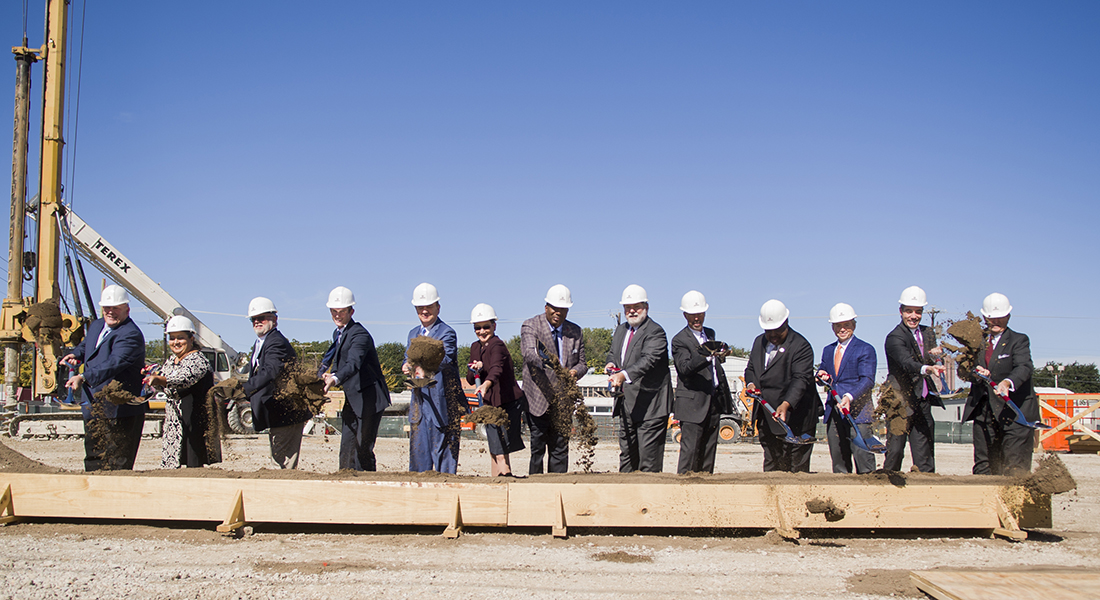If you build it

A short walk from Texas A&M College of Dentistry’s main building, its long-awaited Clinic and Education Building ascends, the construction-site tower cranes commingling with at least a dozen others that hover over the downtown Dallas environs like metallic arachnids.
The new structure’s walls will encompass more modernization than meets the eye on its detailed blueprints. A curriculum redesign is part and parcel of the change in clinical location.
“We are at a critical point right now in executing our mission to educate the next generation of oral health professionals,” says Dr. Lawrence Wolinsky, dean.
“This new facility represents an important step forward in our ability to meet the future needs of both patients and dental education.”
A “group practice” curriculum model is the equally weighty but less tactile project arising in tandem with the new building, aimed at enhancing critical thinking and patient-centered care. The coordinated timing of these two monumental tasks – building construction and curriculum
change – is not mere coincidence.
“Our new building will be eye-catching, but its biggest plus is how its features were designed around the concept of the new curriculum,” says Dr. Steve Griffin ’85, associate dean for clinical affairs, who is overseeing the building project as chair of the Dental Education Facility Task Force.
Plans for a new structure are 14 years in the making, with Griffin active from the beginning. Focused preparations intensified in early 2014.

Alone no more
Anyone who lays eyes on the current building’s third-floor dental clinic experiences the “wow” factor of the sea of pale blue dental chairs stretching more than half the length of a football field. Less apparent to the eye is the impact of this arrangement on educational methods: The confined space within each operatory limits collaboration.
In the new building, clinical care will occur among groups of students organized in six general practice “pods,” each consisting of 21 to 24 operatories. Increased square footage around each dental chair will accommodate two or more people – students at various levels of training and faculty members – rendering one-on-one patient visits a thing of the past. Students will be assigned to one of these groups when they enter dental school.
An eye-level view of clinical teaching helps Dr. Jennifer Barrington, clinical associate professor in general dentistry, D4 comprehensive care program director and a group leader for 18 fourth-year dental students, anticipate the impact of this team approach.
“We plan to have first-year dental students involved in direct patient care very early. The new practice model also includes integrating dental hygiene students,” says Barrington, one of 20 faculty members and administrators serving on the college’s Curriculum Task Force. She will lead a pilot group of 12 dental students in the new educational model during the coming year.
“We plan to have first-year dental students involved in direct patient care very early.”
— Dr. Jennifer Barrington
On the clinic floor, conversations that occur routinely between clinical faculty and students about how to manage a patient’s care or the pros and cons of material choices and techniques could reach an even broader set of students in the new clinical facility, she explains.
“In our new group practice model, I can imagine we might have a brief morning session with a clinically relevant theme: whitening methods and materials that are safe and effective for our patients, or the benefits of endodontic treatment vs. extraction and fixed restorative or implant placement,” Barrington says. “There are many ways we could integrate evidence-based dentistry discussions in the clinic.”
A growing trend in education
Wolinsky, a Commission on Dental Accreditation site visitor consultant in addition to his role as dean, observes the national movement in dental education toward this integrated model rather than one organized around patient procedure “silos.”
“Most contemporary dental schools are going toward group practice models in some variation, where they are teaming students together with a faculty manager and have specialists coming into the practice,” he says. “This results in more efficient care under time constraints, which benefits patients but also provides very effective opportunities for peer training by students.”
Texas A&M College of Dentistry’s regional counterparts, the dental schools in Houston and San Antonio, use group practice models. As is the case in Dallas, the opening of Houston’s new building in 2012 coincided in large part with this curriculum shift. San Antonio’s new clinical facilities in 2015 were built after its group practice model was introduced but were designed to support it, according to Griffin.
CODA emphasizes a patient-centered environment and evidence-based dentistry in evaluating accreditation excellence, Griffin says.
“They are not mandating group practices to achieve those two things,” he explains. “But this group model will allow us to better track outcomes on a student who goes through our program. There will be a faculty member who will have a clinical knowledge of that student from beginning to end.”
For patients, the arrangement results in enhanced continuity of care.
“We’ll also have the most advanced technology we can get at this time, including rooms set up for CAD/CAM and 3D printing.”
— Dr. Steve Griffin
“Rather than moving from department to department if they need specialty care or going from one student to another when one graduates, they will remain in that ‘private-practice’ setting,” Griffin explains. “We’ll also have the most advanced technology we can get at this time, including rooms set up for CAD/CAM and 3D printing.”
More than a passing score
There’s an additional stimulus driving this curriculum change, faculty members say: the new Integrated National Board Dental Exam, which every dental student in the country soon will have to pass in order to apply for licensure.
Texas A&M College of Dentistry’s fall 2019 entering dental class will be its first to take the new exam, which will replace the two separate ones currently used to assess students’ biomedical and clinical sciences knowledge – one taken after the first 12 months of dental school and the other in the fourth year. The integrated exam will be case based, with students evaluated simultaneously on clinical knowledge and the supporting basic science.
Curriculum changes stand to give students an edge on this new requirement, say proponents, as the Curriculum Task Force is charged with achieving “vertical” and “horizontal” integration within the dental academic experience. The first entails two aspects: basic sciences taught as a foundation for clinical work, and the assimilation of all student class levels into the clinic. Horizontal integration throughout the basic and clinical sciences is designed to better synthesize knowledge transfer to students.
With co-chairs Dr. Paul Dechow, associate dean for academic affairs; Dr. Dan Jones ’89, department head of public health sciences and director of curriculum; and Grifffin, the task force is exploring ways to combine existing curriculum components.
Just what could this look like in the clinic and classroom?
“We’re looking to integrate science courses in ways that are application based and then pull in the clinical element to see how it works together,” Griffin says. “So, just one example, ‘What are the cellular characteristics of a particular disease, how do you identify them and then how do you diagnose the disease in a patient?’”
Without a doubt, the level of detail required for integrating basic sciences and clinical care throughout the four-year dental curriculum is daunting. The current arrangement, largely compartmentalized by class year, was last modified significantly in the 1990s. However, courses have been added over the past decade to strengthen student proficiency in evidence-based dentistry.
“It’s a very challenging process to fully integrate our curriculum,” says Wolinsky, “but it’s necessary to better prepare our students for the new board exam. It’s important they understand how basic science relates to their clinical care of a patient. From my perspective, that’s why dental education is moving that direction on a national level.”
At stake is an outstanding board pass rate, whether that means the clinical licensing exam or the integrated board exam, Barrington says. Success hinges on the details, she adds, and the process must be collaborative to succeed.
“Our new clinical floor plan is designed around an integrated model. The team approach among students of all levels in the clinic will help blend their didactic learning with the clinical curriculum,” says Barrington. “I remind myself, ‘Here’s where we are now; here’s where we are going.’ That helps me stay focused on the ultimate goal.

“We’re headed toward a well-rounded scenario that will be good for both students and patients. It will increase students’ clinical experiences and training, all with the goal of graduating the most highly skilled, prepared practitioners.”
This article originally appeared in the Spring/Summer 2018 Texas A&M Dentistry magazine.